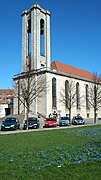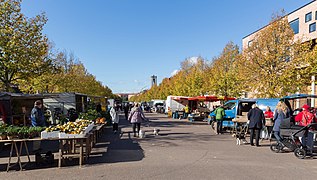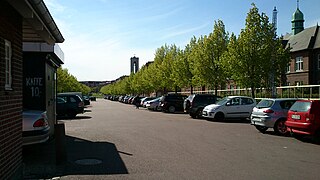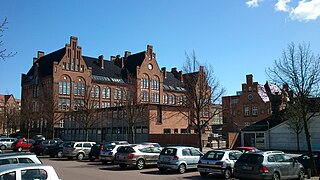
Aarhus is the second-largest city in Denmark and the seat of Aarhus municipality. It is located on the eastern shore of Jutland in the Kattegat sea and approximately 187 kilometres (116 mi) northwest of Copenhagen.

Aarhus C is a postal district in the city of Aarhus, Denmark, consisting of the Inner city, Vesterbro, University of Aarhus, Frederiksbjerg, Langenæs and Aarhus Ø, with postal code 8000. The district is commonly defined as the area enclosed by the ring road of Ring 1, and in the west by the Aarhus Harbour and shoreline.
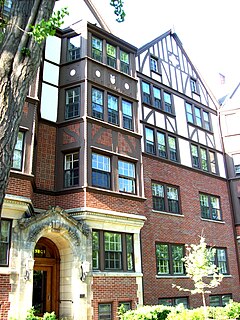
Buckeye–Shaker is a neighborhood on the east side of Cleveland, Ohio. It encompasses two subneighborhoods: in its south and west the old Buckeye neighborhood and in its northeast the Shaker Square neighborhood which is centered on an historic shopping district and an eponymous rapid transit station, located at the intersection of Shaker and Moreland Boulevards, on the light rail line that connects the city of Shaker Heights to downtown Cleveland. From the early to mid-20th century, the Buckeye Road neighborhood was known as Little Hungary, serving as the historic heart of Cleveland's Hungarian community, which at one time was the largest in the world outside of Hungary and for years has been almost completely African-American. Shaker Square, continues to be known as one of Cleveland's most notable neighborhoods, in terms of shopping, dining, architecture, education of its residents, participation in civic life, diversity and quality of living.
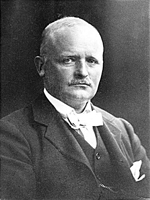
Hack Kampmann was a Danish architect, Royal Inspector of Listed State Buildings in Jutland and professor at the architecture department of the Royal Danish Academy of Fine Arts. Marselisborg Palace in Aarhus, built between 1899 and 1902, is among his best known works.
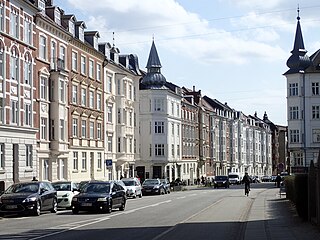
Frederiksbjerg is a borough in Aarhus, Denmark.

Langenæs is a small neighborhood in the city of Aarhus, Denmark with about 6,500 residents, as of 2014. The neighborhood is part of the district Midtbyen and borders the neighborhoods of Frederiksbjerg and Marselisborg to the East and the district of Viby to the South. Langenæs is delimited by the streets Søndre Ringgade, Skanderborgvej, Marselis Boulevard and the valley of Brabrand Ådal.

Nørre Stenbro is a small neighborhood in the city of Aarhus, Denmark home to some 3,000 residents. The neighborhood is part of the Aarhus C district and borders the neighborhoods of Indre By south and west, Aarhus Docklands in the east and Trøjborg north. The residential area of Nørre Stenbro is delimited by the streets Nørre Boulevard, Østboulevarden, Østbanetorvet, Kystvejen, Nørreport and Nørrebrogade, but the large Nordre Cemetery and the smaller residential quarter of Skovvejskvarteret is also part of the same registration.
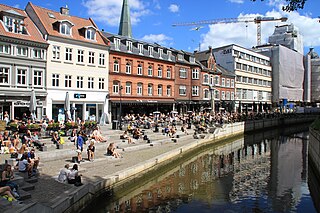
Indre By is a neighborhood in the city of Aarhus, Denmark. The neighborhood is bounded by Nørre Allé, Vester Allé and Sønder Allé and is composed of the neighborhood and historical centre of the Latin Quarter and the areas around the Central Station and the City Hall Park. The neighborhood is one of the three main neighborhoods in the district of Aarhus C, along with Frederiksbjerg and Vesterbro.
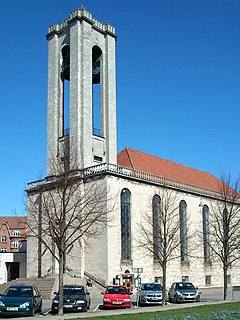
St. Lukas Church is a church in Aarhus, Denmark. The church is situated in the Frederiksbjerg neighbourhood on Skt. Lucas Kirkeplads by Ingerslevs Boulevard. St. Lukas Church is a parish church under the Church of Denmark, the Danish state church, under the Diocese of Aarhus. It is the parish church of St. Lukas Parish which has some 11.000 parish members. The church was designed by architects Anton Frederiksen and Kaj Gottlob in neoclassical style with a 35 meters tall tower. It was constructed between 1921 and 1926 but the crypt under the church, with room for 200 graves, was opened before the church itself, in 1923.
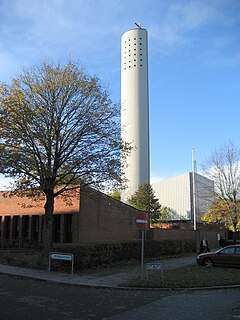
Langenæs Church is a church in Aarhus, Denmark. The church is situated in the southern Langenæs neighbourhood on Langenæs Alle. Langenæs Church is a parish church, and the only church in Langenæs Parish, under the Diocese of Aarhus and within the Church of Denmark, the Danish state church. The church serves some 6.000 parishioners in Langenæs Parish and holds weekly sermons along with weddings, burials and baptisms.

Mejlen or Asylet Børnely is a house, former asylum and a listed building in Aarhus, Denmark. The house was built in 1768 and was listed in the national Danish registry of protected buildings and places by the Danish Heritage Agency on 8 November 2008. The building originally functioned as a kindergarten but is today home to an art gallery.

Vestergade is a street in Aarhus, Denmark, which runs east to west from the central square of Store Torv to the city park of Åparken at Carl Blochs Gade, intersecting the main streets of Grønnegade and Vester Allé along its course. Vestergade begins in the Indre By neighborhood and ends in neighborhood of Vesterbro, close to CeresByen. Vestergade has some of the best preserved 18th-century merchant estates in Aarhus and a history of creativity and artistic expression.

Ludvig Adolph Petersen was a Danish architect, teacher and a founding member and board member of the Architects' Association of Denmark. Ludvig Petersen primarily worked as an architect in Vejle and Aarhus. His parents were Zacharias Petersen, a ship's builder at Holmen in Copenhagen and teacher at the Royal Danish Academy of Fine Arts, and Emilie Sophie Thortsen. His brother was Edvard Petersen, painter and teacher at the Academy of Fine Arts. He married Agnes Theodora Walther, the daughter of Vilhelm Theodor Walther, in 1881 and his son is the botanist and sketch artist Vagn Petersson. Ludvig Petersen died 10 April 1935 and is buried at Holmens Cemetery in Copenhagen.

Læssøesgade School is a public primary school in the Frederiksbjerg district of Aarhus, Denmark. The school offers reception classes, 1 through 10 grades and after-school activities in the Skolefritidsordning (Sfo).

Samsøgades School is a public primary school in the Midtbyen district of Aarhus, Denmark. The school offers reception classes, 0 through 9 grades and after-school activities for some 500 students across 22 classes (2016).

Skansepalæet is a residential building in Aarhus, Denmark situated in the Frederiksbjerg neighborhood. The building comprises Standvejen 34-36 and Heibergsgade 25-27. Skansepalæet was built in 1908 by designs of the Danish architect Hjalmar Kjær as a hotel in connection with the Danish National Exhibition of 1909. Today the building is an apartment complex owned by its residents.

The architecture of Aarhus comprises numerous architectural styles and works from the Middle Ages to present-day. Aarhus has a well-preserved medieval city center with the oldest dwellings dating back to the mid-1500s and some ecclesiastical structures such as St. Clemen's Cathedral and numerous smaller churches that can be traced back to the 1100s. The industrialization of the 19th and 20th centuries left distinctive industrial structures, important National romantic works and some of the best examples of Functionalist architecture in the country. The history of the city as a Viking fort is evidenced in the street layout of the Latin Quarter, the wider Indre By neighborhood testifies to its later role as a Market town and center of commerce while the Frederiksbjerg, Trøjborg and Marselisborg districts showcase the first cohesive urban planning efforts of the early 20th century.

Marselisborg was a farm, manor and barony in Aarhus, Denmark which existed through the 1200s to 1910 under varying ownership and status. The original farm was situated in the present day Marselisborg neighborhood south of the city centre. In 1896 the city of Aarhus purchased the manor and in 1911 dissolved the estate and sold the land off for development. The manor was named after and by Gabriel Marselis who was the first private owner and many landmarks in the area are in turn named for the manor such as Marselisborg Forests, Marselisborg Hospital and Marselisborg Palace.
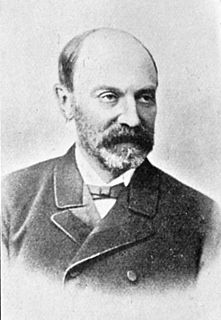
Hans Peter Ingerslev was a Danish politician and minister. He was born in 1831 on Marselisborg Manor in Aarhus, owned by his parents Caspar Peder Rothe Ingerslev and Marie Meulengracht.

Steffen Bernhardt Jensen was a Danish journalist, author, politician and Mayor of Aarhus from 1958 to 1971 for the Social Democratic Party. He was politically active from an early age and later worked as a journalist for several local left-leaning newspapers. During his tenure as mayor, he became known for his opposition to car traffic and he stopped several infrastructure projects that would have required large-scale demolitions of the historic inner city.


